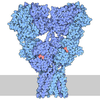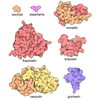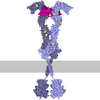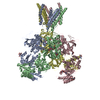+ データを開く
データを開く
- 基本情報
基本情報
| 登録情報 | データベース: PDB / ID: 9arg | |||||||||
|---|---|---|---|---|---|---|---|---|---|---|
| タイトル | Rat GluN1-GluN2B NMDA receptor channel in apo conformation | |||||||||
 要素 要素 |
| |||||||||
 キーワード キーワード | MEMBRANE PROTEIN / Ligand-gated ion channel / ionotropic glutamate receptor / synaptic membrane protein | |||||||||
| 機能・相同性 |  機能・相同性情報 機能・相同性情報cellular response to curcumin / cellular response to corticosterone stimulus / cellular response to magnesium starvation / sensory organ development / pons maturation / positive regulation of Schwann cell migration / regulation of cell communication / sensitization / regulation of cAMP/PKA signal transduction / EPHB-mediated forward signaling ...cellular response to curcumin / cellular response to corticosterone stimulus / cellular response to magnesium starvation / sensory organ development / pons maturation / positive regulation of Schwann cell migration / regulation of cell communication / sensitization / regulation of cAMP/PKA signal transduction / EPHB-mediated forward signaling / auditory behavior / Assembly and cell surface presentation of NMDA receptors / olfactory learning / conditioned taste aversion / dendritic branch / response to hydrogen sulfide / regulation of respiratory gaseous exchange / response to other organism / protein localization to postsynaptic membrane / apical dendrite / regulation of ARF protein signal transduction / response to methylmercury / fear response / transmitter-gated monoatomic ion channel activity / positive regulation of inhibitory postsynaptic potential / response to glycine / propylene metabolic process / response to carbohydrate / interleukin-1 receptor binding / negative regulation of dendritic spine maintenance / cellular response to dsRNA / cellular response to lipid / positive regulation of glutamate secretion / response to growth hormone / regulation of monoatomic cation transmembrane transport / NMDA glutamate receptor activity / Synaptic adhesion-like molecules / RAF/MAP kinase cascade / voltage-gated monoatomic cation channel activity / response to manganese ion / neurotransmitter receptor complex / NMDA selective glutamate receptor complex / ligand-gated sodium channel activity / glutamate binding / response to morphine / regulation of axonogenesis / calcium ion transmembrane import into cytosol / neuromuscular process / regulation of dendrite morphogenesis / protein heterotetramerization / regulation of synapse assembly / male mating behavior / heterocyclic compound binding / glycine binding / positive regulation of reactive oxygen species biosynthetic process / positive regulation of calcium ion transport into cytosol / receptor clustering / parallel fiber to Purkinje cell synapse / regulation of postsynaptic membrane potential / suckling behavior / response to amine / : / small molecule binding / startle response / monoatomic cation transmembrane transport / social behavior / associative learning / behavioral response to pain / response to magnesium ion / regulation of MAPK cascade / action potential / regulation of neuronal synaptic plasticity / cellular response to glycine / extracellularly glutamate-gated ion channel activity / monoatomic cation transport / positive regulation of dendritic spine maintenance / excitatory synapse / positive regulation of excitatory postsynaptic potential / monoatomic ion channel complex / long-term memory / Unblocking of NMDA receptors, glutamate binding and activation / cellular response to manganese ion / behavioral fear response / postsynaptic density, intracellular component / glutamate receptor binding / synaptic cleft / prepulse inhibition / multicellular organismal response to stress / neuron development / detection of mechanical stimulus involved in sensory perception of pain / phosphatase binding / response to electrical stimulus / monoatomic cation channel activity / response to mechanical stimulus / calcium ion homeostasis / response to fungicide / glutamate-gated receptor activity / D2 dopamine receptor binding / regulation of neuron apoptotic process / ionotropic glutamate receptor binding 類似検索 - 分子機能 | |||||||||
| 生物種 |  | |||||||||
| 手法 | 電子顕微鏡法 / 単粒子再構成法 / クライオ電子顕微鏡法 / 解像度: 4.05 Å | |||||||||
 データ登録者 データ登録者 | Chou, T.-H. / Furukawa, H. | |||||||||
| 資金援助 |  米国, 2件 米国, 2件
| |||||||||
 引用 引用 |  ジャーナル: Nature / 年: 2024 ジャーナル: Nature / 年: 2024タイトル: Molecular mechanism of ligand gating and opening of NMDA receptor. 著者: Tsung-Han Chou / Max Epstein / Russell G Fritzemeier / Nicholas S Akins / Srinu Paladugu / Elijah Z Ullman / Dennis C Liotta / Stephen F Traynelis / Hiro Furukawa /  要旨: Glutamate transmission and activation of ionotropic glutamate receptors are the fundamental means by which neurons control their excitability and neuroplasticity. The N-methyl-D-aspartate receptor ...Glutamate transmission and activation of ionotropic glutamate receptors are the fundamental means by which neurons control their excitability and neuroplasticity. The N-methyl-D-aspartate receptor (NMDAR) is unique among all ligand-gated channels, requiring two ligands-glutamate and glycine-for activation. These receptors function as heterotetrameric ion channels, with the channel opening dependent on the simultaneous binding of glycine and glutamate to the extracellular ligand-binding domains (LBDs) of the GluN1 and GluN2 subunits, respectively. The exact molecular mechanism for channel gating by the two ligands has been unclear, particularly without structures representing the open channel and apo states. Here we show that the channel gate opening requires tension in the linker connecting the LBD and transmembrane domain (TMD) and rotation of the extracellular domain relative to the TMD. Using electron cryomicroscopy, we captured the structure of the GluN1-GluN2B (GluN1-2B) NMDAR in its open state bound to a positive allosteric modulator. This process rotates and bends the pore-forming helices in GluN1 and GluN2B, altering the symmetry of the TMD channel from pseudofourfold to twofold. Structures of GluN1-2B NMDAR in apo and single-liganded states showed that binding of either glycine or glutamate alone leads to distinct GluN1-2B dimer arrangements but insufficient tension in the LBD-TMD linker for channel opening. This mechanistic framework identifies a key determinant for channel gating and a potential pharmacological strategy for modulating NMDAR activity. | |||||||||
| 履歴 |
|
- 構造の表示
構造の表示
| 構造ビューア | 分子:  Molmil Molmil Jmol/JSmol Jmol/JSmol |
|---|
- ダウンロードとリンク
ダウンロードとリンク
- ダウンロード
ダウンロード
| PDBx/mmCIF形式 |  9arg.cif.gz 9arg.cif.gz | 515.2 KB | 表示 |  PDBx/mmCIF形式 PDBx/mmCIF形式 |
|---|---|---|---|---|
| PDB形式 |  pdb9arg.ent.gz pdb9arg.ent.gz | 393.1 KB | 表示 |  PDB形式 PDB形式 |
| PDBx/mmJSON形式 |  9arg.json.gz 9arg.json.gz | ツリー表示 |  PDBx/mmJSON形式 PDBx/mmJSON形式 | |
| その他 |  その他のダウンロード その他のダウンロード |
-検証レポート
| 文書・要旨 |  9arg_validation.pdf.gz 9arg_validation.pdf.gz | 1.4 MB | 表示 |  wwPDB検証レポート wwPDB検証レポート |
|---|---|---|---|---|
| 文書・詳細版 |  9arg_full_validation.pdf.gz 9arg_full_validation.pdf.gz | 1.4 MB | 表示 | |
| XML形式データ |  9arg_validation.xml.gz 9arg_validation.xml.gz | 85.1 KB | 表示 | |
| CIF形式データ |  9arg_validation.cif.gz 9arg_validation.cif.gz | 127.9 KB | 表示 | |
| アーカイブディレクトリ |  https://data.pdbj.org/pub/pdb/validation_reports/ar/9arg https://data.pdbj.org/pub/pdb/validation_reports/ar/9arg ftp://data.pdbj.org/pub/pdb/validation_reports/ar/9arg ftp://data.pdbj.org/pub/pdb/validation_reports/ar/9arg | HTTPS FTP |
-関連構造データ
| 関連構造データ |  43781MC 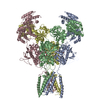 9areC 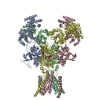 9arfC 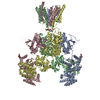 9arhC 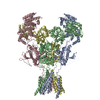 9ariC 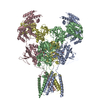 9bibC M: このデータのモデリングに利用したマップデータ C: 同じ文献を引用 ( |
|---|---|
| 類似構造データ | 類似検索 - 機能・相同性  F&H 検索 F&H 検索 |
- リンク
リンク
- 集合体
集合体
| 登録構造単位 | 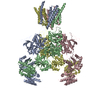
|
|---|---|
| 1 |
|
- 要素
要素
| #1: タンパク質 | 分子量: 95225.883 Da / 分子数: 2 / 由来タイプ: 組換発現 / 由来: (組換発現)  発現宿主:  参照: UniProt: P35439 #2: タンパク質 | 分子量: 98888.945 Da / 分子数: 2 / 由来タイプ: 組換発現 / 由来: (組換発現)  発現宿主:  参照: UniProt: Q00960 Has protein modification | Y | |
|---|
-実験情報
-実験
| 実験 | 手法: 電子顕微鏡法 |
|---|---|
| EM実験 | 試料の集合状態: PARTICLE / 3次元再構成法: 単粒子再構成法 |
- 試料調製
試料調製
| 構成要素 | 名称: Di-heterotetrameric GluN1-GluN2B NMDA receptors / タイプ: COMPLEX / Entity ID: all / 由来: RECOMBINANT |
|---|---|
| 分子量 | 値: 0.400 MDa / 実験値: NO |
| 由来(天然) | 生物種:  |
| 由来(組換発現) | 生物種:  |
| 緩衝液 | pH: 7.5 |
| 試料 | 濃度: 4 mg/ml / 包埋: NO / シャドウイング: NO / 染色: NO / 凍結: YES |
| 試料支持 | グリッドのタイプ: Quantifoil R1.2/1.3 |
| 急速凍結 | 装置: FEI VITROBOT MARK IV / 凍結剤: ETHANE / 湿度: 85 % / 凍結前の試料温度: 285 K |
- 電子顕微鏡撮影
電子顕微鏡撮影
| 実験機器 |  モデル: Titan Krios / 画像提供: FEI Company |
|---|---|
| 顕微鏡 | モデル: FEI TITAN KRIOS |
| 電子銃 | 電子線源:  FIELD EMISSION GUN / 加速電圧: 300 kV / 照射モード: FLOOD BEAM FIELD EMISSION GUN / 加速電圧: 300 kV / 照射モード: FLOOD BEAM |
| 電子レンズ | モード: BRIGHT FIELD / 最大 デフォーカス(公称値): 2800 nm / 最小 デフォーカス(公称値): 1400 nm |
| 撮影 | 電子線照射量: 66.3 e/Å2 フィルム・検出器のモデル: GATAN K3 BIOQUANTUM (6k x 4k) |
- 解析
解析
| EMソフトウェア |
| |||||||||||||||||||||||||||||||||
|---|---|---|---|---|---|---|---|---|---|---|---|---|---|---|---|---|---|---|---|---|---|---|---|---|---|---|---|---|---|---|---|---|---|---|
| CTF補正 | タイプ: NONE | |||||||||||||||||||||||||||||||||
| 3次元再構成 | 解像度: 4.05 Å / 解像度の算出法: FSC 0.143 CUT-OFF / 粒子像の数: 60195 / 対称性のタイプ: POINT | |||||||||||||||||||||||||||||||||
| 原子モデル構築 | プロトコル: BACKBONE TRACE | |||||||||||||||||||||||||||||||||
| 原子モデル構築 | PDB-ID: 7SAA Accession code: 7SAA / Source name: PDB / タイプ: experimental model | |||||||||||||||||||||||||||||||||
| 拘束条件 |
|
 ムービー
ムービー コントローラー
コントローラー








 PDBj
PDBj